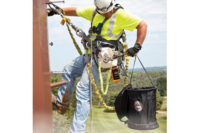One fall can be traumatizing- and costly
10,000 construction workers sustain fall injuries annually

Fall prevention and protection is a primary focus of construction industry safety programs for good reason. According to the Centers for Disease Control and Prevention, falls are the number one cause of construction-worker fatalities, accounting for one-third of on-the-job injury deaths in the industry.
Each year in the U.S. ,more than 200 construction workers are killed and more than 10,000 are seriously injured by falls. In addition to permanent injuries and lost lives as the result of falls, businesses lose billions of dollars each year from significant increases in insurance premiums, workers’ compensation claims, product liability costs, and other related expenses. Additionally, the low morale of seeing a severe injury to a coworker can be traumatizing and decrease productivity from the remaining workers. All of these factors make the impact of even one fall from a relatively short height extremely high, and their prevention extremely valuable.
Leading construction companies that strive to eliminate all injuries — including those from falls — take a multi-pronged safety approach that focuses on:
- Eliminating construction safety risks during design;
- Building a strong safety culture that reinforces 100-percent compliance with fall protection measures, and
- Researching and implementing the latest in certified safety equipment related to fall protection.
Fostering a strong safety culture
Developing a strong safety culture has the single greatest impact on injury reduction. For this reason, creating a safety culture should be a core value for all businesses. Everyone feels responsible for safety and pursues it on a daily basis – whether it is committing to always tying off or being responsible for stopping unsafe actions of fellow workers – employees go beyond the call of duty to identify unsafe conditions and behaviors and intervene to correct them. It becomes engrained in who they are and what they do because safety becomes a natural element of their daily routine and planning process.
Companies that understand the true value of safety have embraced it to protect their workers; celebrating milestones and rewarding workers who are observant and keep the workplace safe. Organizations like these are building a culture of safety where every employee has a vested interest in being safe and is empowered to correct unsafe any unsafe action.
The onus is on the employer to ensure that safety values are translated into action. It requires consistent, demonstrable safety leadership whereby the entire management structure proactively and visibly shows its commitment to safety on a daily basis. It demands that nothing is placed at a higher level of importance, regardless of a potential impact to schedule or budget.
Eliminating construction safety risks during design
A safety culture is not only applicable to the on-site construction team; it can begin during the design phase of a project. Making safety an essential consideration as the team plans the job, the budget, and works with the design team allows preconstruction professionals and project managers to eliminate safety risks by designing safety into the job. Prevention through design techniques include constructability reviews, material equipment and selection, maximizing prefabrication opportunities, and utilizing building information modeling to identify safety hazards in a virtual environment before ever setting foot on a jobsite.
For example, when designing mechanical and electrical rooms in which (a) the ceiling of the room is above a single story; and (b) the installation of the equipment, piping, ductwork and conduit make safely working at heights extremely challenging, the design should accommodate interim tie off points that can be accessible as workers begin to work above six feet. Another option to eliminate this risk is the installation of catwalks to avoid the need for extensive PPE.
Early efforts to find safer ways to build carry over from preconstruction through the submittal, procurement, and fabrication phases. A team's early and proactive focus on safety establishes a team commitment to safety from the beginning.
The latest in certified safety equipment
Forward-thinking companies invest in the latest technologically advanced safety equipment because they realize that traditional equipment is not the only preventive measure to protect workers from falls.
For example, head protection may not be the first thing that comes to mind when considering fall protection, but work-related traumatic brain injury (TBI) as the result of falls is a catastrophic event that leads to disabilities and high socio-medical costs. In a report from the National Institute for Occupational Safety and Health, construction workers sustain more TBIs than employees at any other type of workplace in the United States. Researchers recommend that safety interventions must be emphasized in the construction industry. To that end, new high-tech construction safety helmets with chin straps are being used by early-adopting companies.
The new helmets with chin straps — which look like helmets used in adventure sports such as cycling and rock climbing — protect employees from dropped objects, flying debris, and offer protection from falls. The helmet weight is evenly distributed across the wearer’s head making the headgear more comfortable and offering more protection against impacts on the head. And most important, these new helmet designs include chinstraps that make it less likely to come off if a worker falls.
Conclusion
The need for innovative ways to prevent workplace injuries is crucial. Dr. David Michaels, former assistant secretary of labor for occupational safety and health, stated, “OSHA believes advances in technology and greater flexibility will reduce worker deaths and injuries from falls.”
A forward-thinking company aims to create a higher standard of worker safety, particularly in regard to fall protection. A multi-pronged approach that focuses on culture; elimination of risk; and adoption of research-based, innovative PPE, will lead to fewer injuries and a safer work environment.
- http://www.arbill.com/arbill-safety-blog/the-importance-of-fall-protection (accessed September 25, 2017).
- https://www.usfosha.com/osha-articles/preventing-falls-in-the-workplace.aspx (accessed October 5, 2017).
Looking for a reprint of this article?
From high-res PDFs to custom plaques, order your copy today!





